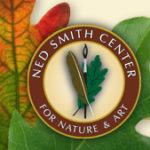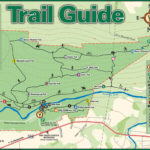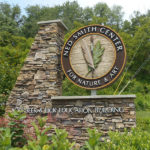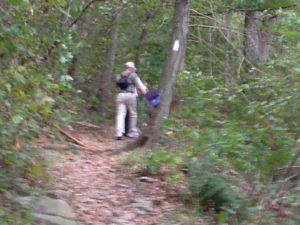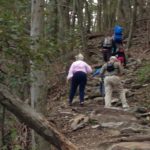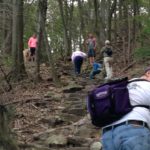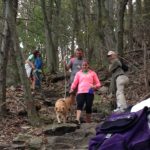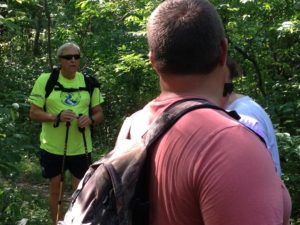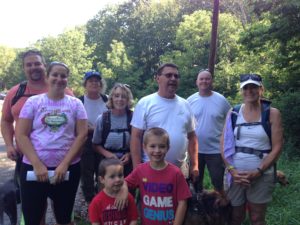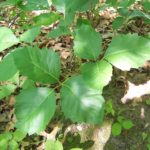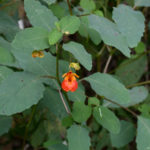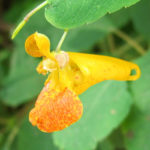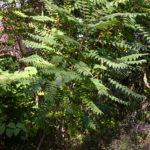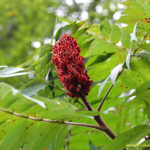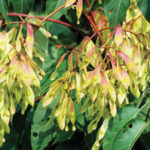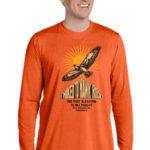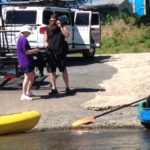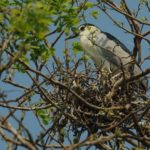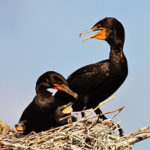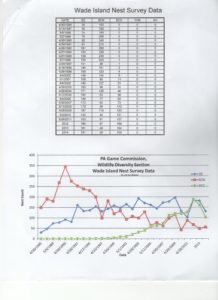 On Sat., January 21st join the Duncannon Outdoor Club (DOC) at The Ned Smith Center in Millersburg for an average paced 5 mile hike on moderate to strenuous terrain. There is one .75 mile climb up Mountain Laurel Trail to Berry Mountain Trail with a nice view at the top. Return on Berry Mountain Trail to Deer Run Trail. Then take Drumming Log Trail back to the starting point at the Ned Smith Center. If snow or ice is on the trail bring Microspikes or Yaktrax if you have them. Wear something orange for the hunting season. The theme for discussion will be coyotes. Meet 9:00 am. at the Holy Spirit Duncannon Center, a Geisinger Affiliate (formally the Duncannon Family Health Center) to carpool or alternately meet at the Clarks Ferry Bridge (RT 147/322) parking lot at 9:15 am. Please reimburse drivers 10 cents for a total of 36 miles. Call Deb at 395-2462 or email dtakach@duncannonatc.org to register. Click here for larger printable versions of the Ned Smith trail map.
On Sat., January 21st join the Duncannon Outdoor Club (DOC) at The Ned Smith Center in Millersburg for an average paced 5 mile hike on moderate to strenuous terrain. There is one .75 mile climb up Mountain Laurel Trail to Berry Mountain Trail with a nice view at the top. Return on Berry Mountain Trail to Deer Run Trail. Then take Drumming Log Trail back to the starting point at the Ned Smith Center. If snow or ice is on the trail bring Microspikes or Yaktrax if you have them. Wear something orange for the hunting season. The theme for discussion will be coyotes. Meet 9:00 am. at the Holy Spirit Duncannon Center, a Geisinger Affiliate (formally the Duncannon Family Health Center) to carpool or alternately meet at the Clarks Ferry Bridge (RT 147/322) parking lot at 9:15 am. Please reimburse drivers 10 cents for a total of 36 miles. Call Deb at 395-2462 or email dtakach@duncannonatc.org to register. Click here for larger printable versions of the Ned Smith trail map.
Category Archives: Announcements
DOC/ATC National Family Hiking Day
 The Duncannon Outdoor Club (DOC) joined the Appalachian Trail Conservancy (ATC) in their efforts to celebrate National Family Hiking Day in September, 2016. The DOC offered a “hike at your own pace” hike up to Hawk Rock. Prior to the assent participants decorated tree cookie necklaces provided by the ATC. They were so popular that other hikers at the top inquired how to get a necklace.
The Duncannon Outdoor Club (DOC) joined the Appalachian Trail Conservancy (ATC) in their efforts to celebrate National Family Hiking Day in September, 2016. The DOC offered a “hike at your own pace” hike up to Hawk Rock. Prior to the assent participants decorated tree cookie necklaces provided by the ATC. They were so popular that other hikers at the top inquired how to get a necklace.
Participants included a wide range of ages. A baby, kids, adults and three dogs comprised our list of adventurers. Many of our hikers had always wanted to hike Hawk Rock but were hesitant to do so independently or in a group because of the difficulty. When given the option to hike at one’s own pace in a group with an experienced leader, hikers chose to enjoy a safe, comfortable alternative and mastered the climb. Everyone made it to the top and back successfully without incident.
In order to motivate the hikers and make it entertaining, thirty riddles, with answers on the flip side, were posted along the way. Many hikers, not with our group, read the riddles as they hiked up and down the mountain. A big thank you goes to Sean O for posting the riddles ahead of time. Riddles were removed by the sweep so as to leave no trace. What was the riddle at the top? : What does a mountain and an addition problem have in common? (answer at article’s end).
Below are pictures depicting the event.
- Heading up the mountain.
- Almost there. One on the way down.
- At the top.
- Taking in the view.
- View from another angle.
- Taking turns on the rock.
- Reggie and John take a break.
- On the way back down.
Answer to the riddle: You sum it.
Duncannon Outdoor Club Hike at Pine Grove Furnace State Park, Theme Lyme Disease
 On Sat., Dec. 17th join the Duncannon Outdoor Club (DOC) at Pine Grove Furnace State Park for a 7 mile, average paced, loop hike on moderate terrain to Pole Steeple. This hike will include one climb that rises 500 ft. for three-quarters of a mile. If there is snow on the mountain tops wear micro spikes or Yak Traks if you have them. We will be learning about Lyme Disease and how to prevent it. Meet 8:30 am. at the Duncannon Holy Spirit Center, a Geisinger Affiliate (formally the Duncannon Family Health Center) to carpool or alternately meet at the K Mart in Enola at 9:00 am. Pack a lunch and don’t forget fluids. Wear something orange for the hunting season. Please reimburse drivers 10 cents a mile. Total miles = 52 miles from K Mart and back. Call Deb at 395-2462 or email dtakach@duncannonatc.org to register. Hope you can make it!
On Sat., Dec. 17th join the Duncannon Outdoor Club (DOC) at Pine Grove Furnace State Park for a 7 mile, average paced, loop hike on moderate terrain to Pole Steeple. This hike will include one climb that rises 500 ft. for three-quarters of a mile. If there is snow on the mountain tops wear micro spikes or Yak Traks if you have them. We will be learning about Lyme Disease and how to prevent it. Meet 8:30 am. at the Duncannon Holy Spirit Center, a Geisinger Affiliate (formally the Duncannon Family Health Center) to carpool or alternately meet at the K Mart in Enola at 9:00 am. Pack a lunch and don’t forget fluids. Wear something orange for the hunting season. Please reimburse drivers 10 cents a mile. Total miles = 52 miles from K Mart and back. Call Deb at 395-2462 or email dtakach@duncannonatc.org to register. Hope you can make it!
Duncannon Winterfest 2016
 We had a blast at Winterfest last night in Duncannon, PA! It was a nice little get-together at the Clark’s Ferry Tavern located at 600 North Market Street with about 12 different community groups, a campfire, some festive holiday yard decorations, Santa Claus, a Christmas tree, a DJ, and a few hundred happy people enjoying a night together in an average little American town.
We had a blast at Winterfest last night in Duncannon, PA! It was a nice little get-together at the Clark’s Ferry Tavern located at 600 North Market Street with about 12 different community groups, a campfire, some festive holiday yard decorations, Santa Claus, a Christmas tree, a DJ, and a few hundred happy people enjoying a night together in an average little American town.

The Duncannon Appalachian Trail Community set up a table near the campfire (of course) with our informational brochures, T-shirts, AT postcards made by Susquenita Middle School students, cookies, snacks, apple cider, and our most popular item of the night, reindeer crafts for the kids! Thanks to the hard work and generosity of DATC member Deb Takach, we helped Duncannon children assemble 50 cardboard tube reindeer tree ornaments. That’s 100 googly eyes, 200 pipe cleaner pieces, 50 yarn scarves, and 101 holes poked! That one extra hole went into my finger, (I shouldn’t be allowed to play with scissors). Unfortunately, we ran out of reindeer in the first hour but we had plenty of free goodies to hand out to the kids and their parents thanks to DATC members Patrick W. and Robyn S.
Patrick made delightful cookies with currants, nuts, and a coffee glaze; and Robyn made tasty treats combining pretzels, chocolate, and candies. Paul S. manned the free cider station while spreading the word about all of the good work the DATC does and fielding questions about trees, bugs, and wildlife. Me? I just tried not to bleed on the reindeer as I poked the holes for their little pipe cleaner antlers.
Special thanks to The Duncannon Parks and Recreation Committee and all of the other volunteers who came together to arrange such a pleasant event.
DOC Poison Ivy, Poison Oak and Poison Sumac
- Heading out
- At the half-way point
We had a good turnout for the August, out and back hike from Scott’s Farm to Sherwood Drive and were fortunate enough to have some very energetic youngsters. Toward the half way mark though they started to show signs of fatigue, until it was suggested that they lead the hike back. Boy! Did we ever see a revitalization in energy! It was hard to keep up.
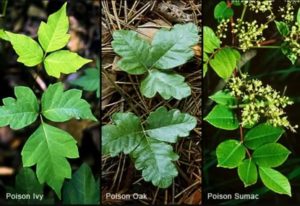 The theme for the event was poison ivy, poison oak and poison sumac. We observed poison ivy, but were neither able to locate poison oak nor poison sumac.
The theme for the event was poison ivy, poison oak and poison sumac. We observed poison ivy, but were neither able to locate poison oak nor poison sumac.
Poison sumac was not evident, because It is found in wet marshy areas, and we were not in a wet habitat. Poison oak does not grow in PA. People mistake poison ivy for poison oak, which grows in states south of PA, so we addressed the topics of poison ivy and poison sumac.
We discussed the three forms of poison ivy and identified each. Poison ivy can be found growing low to the ground, as a shrub, or as a hairy vine. Vines can grow up a tree, overtake the tree crown and kill it. To the untrained eye the dead tree will look alive and healthy when the crown is 100% poison ivy!
- Low Growing Plant
- Shrub Like
- A Vine Overtakes a Tree
Remember, “Leaves of three, let it be!” A berry plant, like blackberry or raspberry, also has three leaves, however the thorny stems are a dead give away that it is not poisonous. Poison ivy leaves of three consist of a stem with a larger leaf at the end and two smaller leaves shooting off the sides. The leaves have pointed tips and can be notched or smooth on the edges. The plant will have different appearances depending upon the season. Leaves are reddish in spring, green in summer and a yellow/orange in the fall.
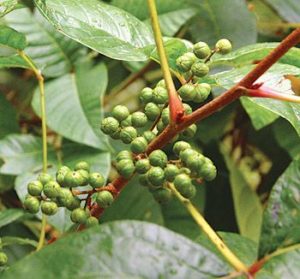 Poison ivy berries are a good source of food for many animals. Birds will eat the berries and spread the seeds through defecation; one reason you may have a problem with poison ivy under your bird feeders. Poison ivy berries are greenish-white and can be seen through the spring and summer.
Poison ivy berries are a good source of food for many animals. Birds will eat the berries and spread the seeds through defecation; one reason you may have a problem with poison ivy under your bird feeders. Poison ivy berries are greenish-white and can be seen through the spring and summer.
One cannot discuss poison ivy with out mentioning the antidote, jewel weed. Touch Me Not is another name for this plant, because the seeds explode out of the pod when touched. If the leaves and stem of jewel weed are crushed and the juices rubbed on your skin, you will not get poison. The juices counteract the poison in poison ivy. Jewel weed flowers can be orange, yellow or spotted and hang from the plant like a jewel on a necklace.
- Jewel Weed Orange Flower
- Jewel Weed Yellow Flower
Poison Sumac is often confused with smooth sumac, staghorn sumac and tree of heaven.
- Poison Sumac
- Non-Poisonous Sumac
- Tree of Heaven
Poison sumac will be found in a wet marshy area while non-poisonous sumac (staghorn and smooth sumac being the most common), and tree of heaven live in poor soil and drier habitats. The leaves of poison sumac are compound, oval, elongated, and smooth-edged, usually 2-4 inches long. The stems are generally red with 7-13 leaves in pairs. Leaves are bright orange in spring, dark green in summer and red-orange in the fall. In comparison, the leaves of non-poisonous sumac are serrated and the leaves of the tree of heaven have a noticeable notch on the lower pairs of leaves at the base. Staghorn sumac branches are also covered with a soft fuzz like the velvet on a stag’s antlers.
- Poison Sumac Berries
- Staghorn Sumac Berries
- Tree of Heaven Samara
Fruits from each of the aforementioned species also provide a means for identification. Poison sumac has white or grayish berries while staghorn sumac has small round, hairy berries in a cone shape. “White mean’s fright, red delight!”, is a saying that helps you remember which plants to stay away from. Why a delight for the staghorn sumac? Those red berries are edible and make a delicious drink when soaked in cold water and the hairs are strained out of the liquid. Add water and honey to taste.
The tree of heaven has samaras which are winged seeds found only in the female tree of heaven and are easy to differentiate from the poison and non-poisonous sumac berries.
Now you can venture into the out of doors with a clear knowledge of the most common poisonous plants to avoid in Pennsylvania. Oh, by the way. Do not touch those hairy poison ivy vines even in the winter or you may develop a case of poison ivy! If you burn poison ivy or poison sumac do not breath in the smoke or let it touch your skin or you may be very sorry!!
Buy Hawk Rock T-Shirts!
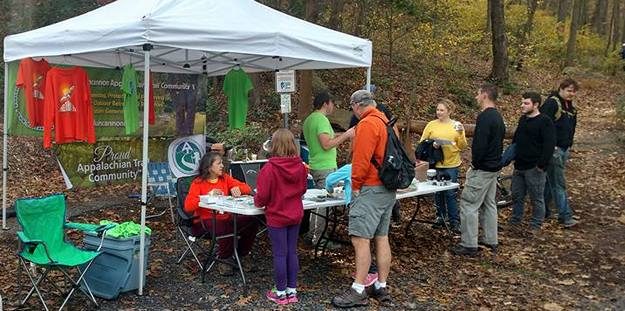
Many people told us they wanted to buy a super awesome “I hiked to Hawk Rock” shirt but they couldn’t come to Hawk Rock to buy one in person. That’s why we’re currently accepting orders for more shirts via email until Wednesday November 23rd. Shirts ordered before November 23rd will be available for pickup at The Doyle Hotel starting Saturday, December 3rd. And to show our appreciation for The Doyle’s cooperation, the DATC will donate one dollar to The Doyle for every shirt you buy!
- Long Sleeves
- I Hiked To Hawk Rock!
- Short Sleeves
These high performance orange shirts are soft to the touch, 100% polyester, jersey knit, Aqua FX ® (for wicking properties), Freshcare ® (for anti-microbial properties), and darn good looking too. Long sleeves are $20 and short sleeves are $15 (2XL and 3XL are $3 more).
You can also order our green short sleeve DATC logo shirts for only $10. They’re 50/50 Poly/Cotton and come in sizes S, M, L, XL, 3XL, and 4XL (3XL and 4XL are $2 more – 2XL are sold out).
- Short Sleeves
- DATC Logo
Send an email to shirts@duncannonatc.org before November 23rd and your order will be ready for pickup at The Doyle on December 3rd. Be sure to specify quantity, color (orange or green), sleeve length, and size when ordering.
We look forward to hearing from you. You’re going to look great in these shirts!
DOC November Hike Tree Identification
Want to learn how to identify trees? On Sunday, November 20th come out for a hike with the DOC as we learn the secrets to tree identification. We will hike in and out for a total of 2 miles at an average pace over easy terrain off RT 325 on state game lands. Meet at the Holy Spirit Duncannon Center at 9:00 am. to carpool or alternately at 9:30 am. at the intersection of RT 225 and RT 325 (parking area – 40.38867,-76.94168). Call Paul at 648-8226 or email psmith@duncannonatc.org to register. For precaution purposes wear something orange.
It’s For The Birds
- The brave river goers
- Waiting a turn to load up.
- Docking at West Fairview,
- Shuttle has arrived
This summer the Duncannon Outdoor Club planned a boating trip. Eight brave boaters tackled a very rough Susquehanna River from Marysville to West Fairview. High winds and water nearly swamped us as we headed from Blue Mountain Outfitters to the river left. The ledges and rocks were not visible due to the high water and whitecaps caused by the ever roaring wind. This resulted in one of the canoes capsizing, but other than a sudden dunking everything turned out okay. Once in between the islands the winds were dissipated and we were able to relax a little. All in all everyone had a great time, asking, “Can we do this again?”
- Great White Egret
- Black-Crowned-Night Heron
- Double-Crested Cormorant
When sheltered by the islands, we floated by Wade Island being careful to keep our voices down due to the nesting colonies of the endangered Great White Egrets, Black-Capped-Night Herons and the ever increasing, invading Double-crested Cormorants. Wade Island is a designated Pennsylvania Audubon Important Bird Area and is not open to the public, but can be observed by boat.
Many people are not aware that the Great White Egret is endangered, because they are a common sight in our area. However, there are only two nesting sites in PA. A small colony in York County on the Kiwanis Lake and the largest colony which inhabits Wade Island.
The Black-Crowned-Night Heron is also endangered and more illusive then the Great White Egret. Unfortunately the colonies of both these species have declined and continue to do so due to loss of habitat, water pollution, and nesting site disturbances. Such is the case of the Cormorant colony which has disturbed the nesting site, taking prime nesting spots, and damaging habitat on Wade Island by sheer numbers and nesting habits.
Cormorants used to be rare in this area, but have increased greatly in numbers over the years. It is believed that their increasing numbers are a result of expanding fish hatcheries in the south and a larger number of small fish in the Great Lakes. Cormorants nest high in trees or on the ground of islands. On Wade Island they take prime nesting habitat in trees limiting the sites for the Great White Egret and Black-Crowned-Night Heron. Feces fall in large amounts on those below and kills trees and herbaceous growth on the island. Cormorants also damage the trees when they collect nesting material. This was evident in our trip as we passed the island. This is unfortunate for the Great White Heron and Black-Crowned-Night Heron since they nest only in the trees. When all the trees die, the Cormorants are known to nest on the ground.
In 2006, 2011, 2012 and 2013 a number of Cormorants were culled by marksmen under the direction of the Pennsylvania Game Commission and the U.S Department of Agriculture’s Wildlife Services. The chart below shows the results. Note the decrease in Great White Egrets (red) and Black-Crowned-Night Herons (blue) as the population of Double-Crested Cormorants (green) increased. Gaining Information regarding future culling was attempted from various sources without success.
Some people feel that we should not cull the Cormorants and let Mother Nature take her course. Others disagree believing that mankind made the changes responsible for the increasing number of these birds, and it is mankind who must remediate the results of their actions. What do you think?
KTA Trail Challenge – 2016
 Several members of the Duncannon Appalachian Trail Community were among more than one hundred volunteers who helped facilitate Keystone Trails Association‘s eighth annual Super Hike. The Super Hike has been renamed the KTA Trail Challenge to more accurately reflect the efforts of over 400 trail runners who took to the hiking trails of York and Lancaster counties on a very hot and humid September tenth.
Several members of the Duncannon Appalachian Trail Community were among more than one hundred volunteers who helped facilitate Keystone Trails Association‘s eighth annual Super Hike. The Super Hike has been renamed the KTA Trail Challenge to more accurately reflect the efforts of over 400 trail runners who took to the hiking trails of York and Lancaster counties on a very hot and humid September tenth.
The 25 kilometer runners began at Susquehannock State Park and the 50K runners began at the Pequea Creek Campground. Both groups crossed the finish line at Otter Creek Campground where they were rewarded with, not only bells and whistles, but also medallions and t-shirts followed by a picnic supper. Hardy runners and trail hikers are encouraged to start training for next year’s KTA Trail Challenge.
Keystone Trails Association members and their friends are preparing for their fall membership meeting and hiking weekend which will be held October 13th thru the 16th at Whitehall Camp and Conference Center in Emlenton, Clarion County. Hiking will be a big part of the weekend as well as learning more about Grandma Gatewood, glass blowing, the Allegheny River, and the North Trail. Reservations are open through October 16th.
A Hike and Spooky Stories!
On Sat., Oct. 15th join the Duncannon Outdoor Club (DOC) for a 2 mile average paced night hike through the wooded cross country trails behind Susquenita High School. The terrain is moderate to easy with a few short climbs. Stop at the abandoned cemetery for some scary stories told by Wilhalmina Dorotheea Roskabower Kaufman. Bring a sit upon if you wish to sit during the story telling. Bring flashlights or headlamps. Meet at the left side of the Susquenita High School Parking lot closest to the building at 7:00 pm. (309 Schoolhouse Rd. Duncannon – along 11/15) Call 395-2462 or email dtakach@duncannonatc.org to register.

